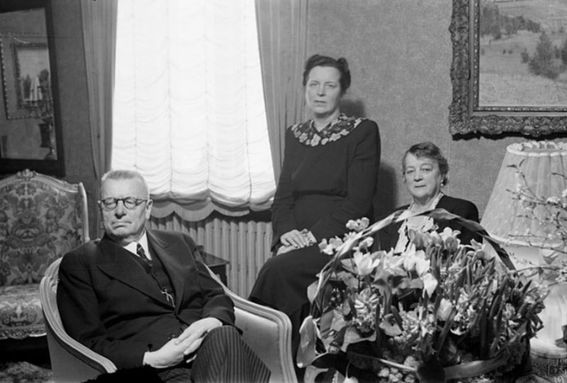Leave a better future as your legacy
A legacy gift for the university is a step towards a better future.

Architect Annikki Paasikivi Scholarship Fund (Paasikivi was the daughter of President Juho Kusti Paasikivi) operates actively at Aalto University as part of the funds in the fields of education. Every year, dozens of scholarships are awarded to students of architecture from the fund established in the 1950s. This is a significant support for students, and a great number of future architects apply for it each year.
In 2022, a total of 95,279 euros, or 40 scholarships, was distributed from the Fund. This is a so-called capitalizing fund, from which income is distributed once a year. The Department of Architecture will decide on this year's scholarship recipients on 3 October 2023. The funds are distributed to students based on academic performance.
Over the decades and centuries, the education of architects has expanded to numerous new areas. Their work can be seen on the streets of cities and in urban centres. It is the history and future of our planned and built environment. The goal of the Department of Architecture is to train critical thinkers who take responsibility for designing and researching a socially, culturally, and ecologically sustainable built environment.

Annikki Paasikivi was born in Helsinki on 20 November in 1898. Her father was Juho Kusti Paasikivi, who served as President of the Republic between 1946 and 1956, and her mother Anna Paasikivi, who was also an active social actor. Annikki was the first child of the family, and the family grew later with one daughter and two sons.
Annikki graduated from the Helsinki Finnish Coeducational School in 1916 and started architectural studies at the Helsinki University of Technology in 1917. The educational institution called Polyteekki was located on Abrahaminkatu by Hietalahdentori in a neo-renaissance building that was completed in 1877 and designed by F. A. Sjöström. At that time, nearly a third of students at the Department of Architecture were women. Currently, the majority of students of architecture are female.
During the spring of Annikki's first year of studies, a civil war broke out that divided the people in two. The female students of technology also participated in the secret assistance tasks of the White Guard, such as transporting weapons and ammunition, in Helsinki, which was occupied by the Red Guard. At the end of the war, Commander-in-Chief C.G.E. Mannerheim awarded them decorations and the 19-year-old Annikki was awarded a 4th Class Cross of Liberty without a sword.
During the autumn term of 1918, the studies could continue again. Annikki graduated as an architect in 1923. The topic of her master's thesis was the Official Residence of the President of the Republic.
In Kerava, the Paasikivi family had a farm called Jukola, where the family spent a lot of time. In 1924, Annikki established an architectural office in the area together with the local construction manager. From this period, at least one residential building designed by Annikki has been preserved in Kerava.
Soon, however, Kainuu and its wilderness, as well as the work offered there, were of such interest that she moved to Kajaani and designed several Civil Guard houses in the region and, among others, the Kansallis-Osake-Pankki building in Kajaani. Annikki also designed rural office buildings for the bank at least in Lohja, Orivesi, Kurikka and Jalasjärvi. The interior design of the movie theatre Atlantis, later Joukola, on Kapteeninkatu in Helsinki was also Annikki's work. One of the few preserved sites of her architectural career was a house she designed for his father in Taka-Töölö, Helsinki, completed in 1930.

Annikki's career as an architect designing buildings lasted only a few years. In the early 1930s, she changed professions. The atmosphere at home had raised her to be socially active, internationally oriented, and exceptionally proficient in languages. She wanted to go abroad for new assignments, and she was particularly interested in the activities of the League of Nations, predecessor of the United Nations. Its headquarters were located in Geneva, Switzerland, where Annikki moved after accepting work from the organisation's information department.
The League of Nations failed in its most important goal of securing world peace, and the Second World War started in autumn 1939. Annikki travelled to Copenhagen in Denmark and worked there in an organisation that handled the affairs of war children who were sent out of Finland.

After the war, Annikki returned to Finland and started work at the Finnish Broadcasting Company (Yle) led by Hella Wuolijoki. The single architect became the programme coordinator of the radio's home shows. With her education, experience, and extensive network of relationships, she suited the job and apparently enjoyed it well.
Annikki lived with her father and his second wife, Alli, in her former home, a house she designed herself. Her father and especially Alli Paasikivi found in her a guide with excellent language skills for many joint trips to Central and Southern Europe. When her father was elected President of the Republic and he moved to the Presidential Palace with his spouse, Annikki moved there with them.
At the beginning of 1950, Annikki was admitted to the hospital. She had had breast cancer earlier and it had spread. The treatments did not save Annikki this time. She died on 25 November 1950, a few days after turning 52.
Annikki was blessed at a solemn funeral, attended by a large crowd, at the Hietaniemi chapel. The flag guard of the student union of the Helsinki University of Technology stood by her coffin. Among others, Alvar Aalto expressed his condolences for the passing of the "delightful and kind Annikki" and the Architecta Suomen Naisarkkitehtien Yhdistys (association of female architects) respected the memory of this "warm-hearted person, our member who was seeking and loving different forms of life".
In her times, Annikki was active in organising funding for the project of establishing the Otaniemi Technology Village. Later, she bequeathed her entire fortune to "the Helsinki University of Technology as a fund bearing the name of architect Annikki Paasikivi, whose proceeds must be used for supporting those indigent students of architecture who have graduated and completed the diploma with scholarships that are decided on by the President of Helsinki University of Technology”.
Text: Liisa-Maria Hakala-Zilliacus (PhD, non-fiction writer) who is preparing the biography of Annikki Paasikivi and Krista Kinnunen, Aalto University Communications.

A legacy gift for the university is a step towards a better future.

